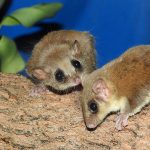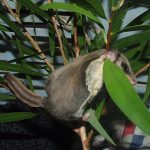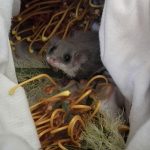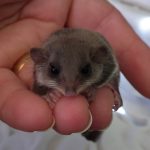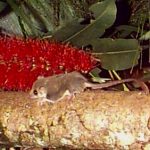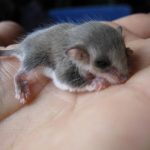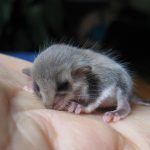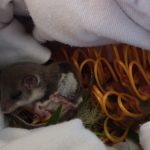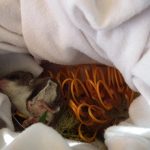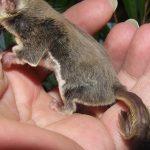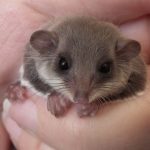FEATHERTAIL GLIDER
The Feathertail Glider: A Tiny Acrobat of the Night
In the enchanting canopy of Eastern Australia’s forests, from the lush landscapes of South Australia to the tropical realms of far north Queensland, dwells a marvel of nature scarcely bigger than a human thumb. The Feathertail Glider, the tiniest member of the gliding possums, boasts a head and body length of merely 6.5 to 8 cm. Yet, what it lacks in size, it compensates with astounding adaptations and a heart full of courage.
Named for its extraordinary tail, the Feathertail Glider possesses a unique feature unmatched in the mammalian kingdom—a tail that mimics the delicate structure of a feather. This remarkable appendage, measuring 7–8 cm, is not merely for show. With stiff, fringed hairs splaying out horizontally along its length, the tail serves as an essential tool for navigation. It acts as a rudder, guiding the glider through the air, steering and braking with precision as it embarks on nocturnal voyages, gliding up to 20 metres between the trees in search of sustenance.
Weighing in at a mere 10–15 grams, this diminutive creature’s presence is often unnoticed, sometimes tragically so when they find themselves in perilous situations. Their size and appearance can lead to mistaken identities, with some unfortunate souls being brought into human homes by cats, an act that often leads to their introduction to wildlife carers.
Adaptations for Survival
The Feathertail Glider hails from the Burramyidae family, sharing lineage with the Pygmy Possum. One of the most fascinating aspects of these tiny gliders is their reliance on torpor—a state akin to a deep slumber—to conserve energy during cold spells or food shortages. During torpor, their metabolic rate slows, their body temperature plummets, and they enter a state of almost suspended animation, a testament to their resilience and adaptability.
Equipped with a gliding membrane that stretches from elbow to knee, edged with long hairs, the Feathertail Glider transforms into a living parachute. This adaptation allows it to glide gracefully, mimicking a falling leaf caught in a gentle breeze, as it traverses the forest canopy. Their diet is as varied as their habitat, feasting on insects, pollen, and nectar, which they forage for among the treetops.
Extraordinary Locomotion
Their method of locomotion is nothing short of astonishing. To initiate flight, they leap into the air, extending their limbs to unfurl the gliding membrane, with their feather-like tail aiding in navigation and landing. Their feet, reminiscent of a frog’s but covered in fur, are equipped with large pads and serrated grooves, enabling them to scale virtually any surface. Remarkably, their foot pads secrete moisture, creating a suction effect that allows them to cling to even smooth vertical surfaces, such as panes of glass.
Ingenious Nest Builders
The Feathertail Glider constructs its nest with meticulous care, utilizing materials ranging from abandoned bird nests to man-made objects like banana bags. These spherical nests, lined with leaves, feathers, and shredded bark, provide a cozy haven for these communal creatures, which can live in groups of up to 30 individuals.
Life Cycle and Social Bonds
Breeding occurs throughout the year in the north, with a seasonal pattern observed in the south. With a lifespan of up to four years in the wild, these gliders navigate a world filled with challenges, their size belied by their indomitable spirit.
An Immersive Encounter
Picture the hush of an Australian dusk. The air is laced with the faint sweetness of eucalyptus and the earthy aroma of rain-soaked bark. High above, a slight rustle—barely perceptible—signals the Feathertail Glider’s awakening. Its silky fur shimmers in the dappled moonlight, whiskers twitching as it sniffs the cool night air. A silent leap, a breathless moment, and it sails effortlessly from branch to branch, the touch of wind ruffling its feathered tail, the forest alive with its gentle passage.
Conservation: Safeguarding a Tiny Marvel
The Feathertail Glider, with its feather-like tail and aerial acrobatics, is a testament to the wonders of evolution and the intricate balance of nature. As urban development and habitat loss threaten these delicate forests, each of us plays a part in their future. By supporting responsible pet ownership, fostering natural habitats, and appreciating the interconnectedness of all life, we can help ensure that these tiny gliders continue to soar through the Australian night sky for generations to come.
| Feature | Description |
|---|---|
| Length | 6.5–8 cm (head and body), 7–8 cm (tail) |
| Weight | 10–15 grams |
| Gliding Distance | Up to 20 metres |
| Diet | Insects, pollen, nectar |
| Lifespan | Up to 4 years in the wild |
| Social Structure | Communal, up to 30 individuals per nest |
| Conservation Status | Least Concern, but habitat loss is a threat |
Let us marvel at the Feathertail Glider not just for its remarkable abilities, but as a reminder of the delicate beauty and resilience woven throughout Australia’s wild places.

